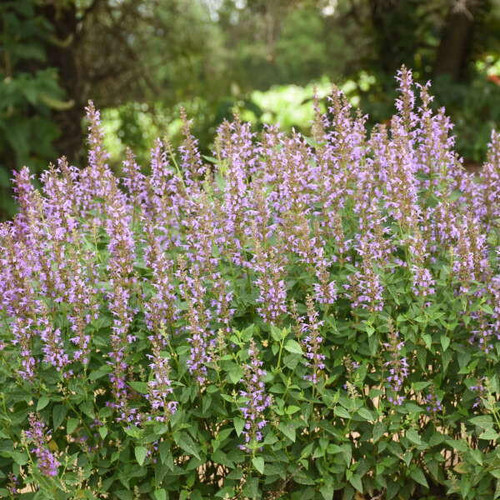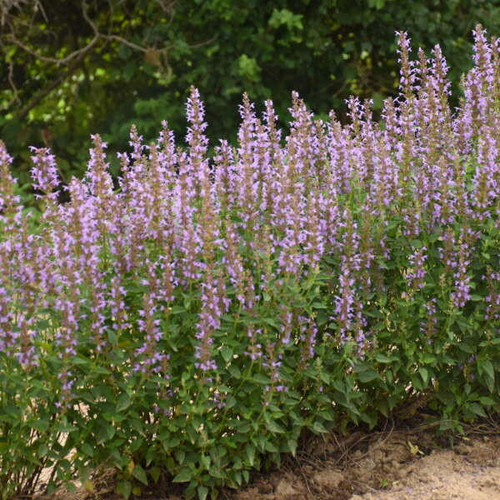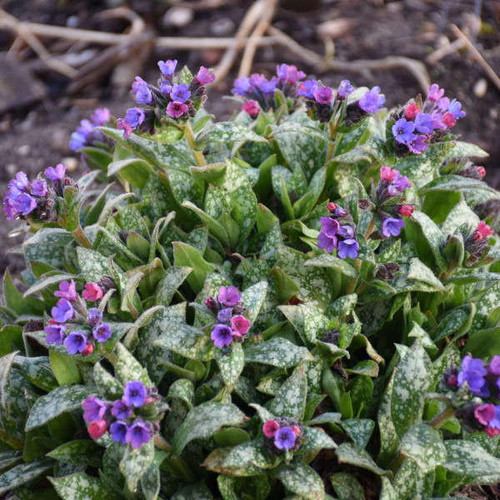Product Description
Pulmonaria 'Pink-a-Blue' PPAF CPBRAF- Proven Winners® (30)ct Flat
Common Name: Lungwort
Pink flower buds open to medium blue flowers in early spring. Buds and blooms appear at the same time for an alluring two tone effect. Following flowering a robust habit of long green leaves dappled with silver spots will hold interest for the remainder of the growing season. The silver spotted foliage is perfect for brightening up the shade and resistant to both browsing deer and rabbits. Compared with 'Spot On', the flower buds are pink instead of salmon, the flowers open a lighter blue, and the foliage is dark as opposed to light green and more narrow.
Height: 16.0-18.0 Inches
Spread: 22.0-24.0 Inches
Hardiness Zones: 3,4,5,6,7,8,9
Flower Color: Purple-blue shades
Foliage Color: Silver/grey shades
Part Shade (4-6 hrs. Direct Sun) to Full Shade (< 4 hrs. Direct Sun)
Average to Consistent Water Needs
Average to Fertile Soil Quality
Bloomtime: Late Spring
Attracts Hummingbirds
Bee Friendly
Deer Resistant
Rabbit Resistant
Growth Rate: Medium
Border Plant, Container, Cut Flower, Cut Foliage, Edging, Attractive Foliage, Mass Planting
Pulmonaria 'Pink-a-Blue', also known as lungwort, is a hybrid variety of Pulmonaria that is prized for its attractive foliage and flowers. This shade-loving perennial is a low-maintenance and relatively easy to grow plant. It is a great addition to any garden, adding pops of color in early spring and interesting foliage throughout the growing season. Let us take a closer look at the characteristics, care, and uses of this beautiful plant.
Pulmonaria 'Pink-a-Blue' is a low-growing plant with a spreading habit. It typically reaches a height of 16-18 inches and spreads 22-24 inches wide. The most striking feature of this plant is its foliage. The leaves are long, green, and speckled with silver spots, providing interest even when the plant is not in bloom. The silver-spotted foliage continues to provide visual interest even after the flowering period ends. In early spring, the plant produces clusters of delicate, bell-shaped flowers. The flowers emerge from pink buds and transition to blue as they mature, creating a beautiful two-toned effect. This unique characteristic makes it a standout in the shade garden. Pulmonaria 'Pink-a-Blue' is also deer and rabbit resistant.
Caring for Pulmonaria 'Pink-a-Blue' To ensure your Pulmonaria 'Pink-a-Blue' thrives, consider the following care tips:
Light and Soil This plant prefers partial shade to full shade. It can tolerate some morning sun, but it is best to protect it from the harsh afternoon sun. The ideal soil for Pulmonaria 'Pink-a-Blue' is moist, fertile, and well-drained. It prefers a neutral to alkaline pH.
Watering Pulmonaria 'Pink-a-Blue' needs consistent moisture, especially during dry spells. However, it is important to avoid overwatering, as this can lead to root rot. Water the plant deeply when the soil feels dry to the touch.
Temperature and Humidity This plant thrives in mild temperatures and prefers cool, humid conditions. It can tolerate some heat, but it may wilt in extreme temperatures. In hot climates, it is best to provide some afternoon shade and keep the soil consistently moist.
Fertilizing Pulmonaria 'Pink-a-Blue' is not a heavy feeder. A light application of balanced fertilizer in the spring is usually sufficient. Avoid over-fertilizing, as this can reduce flowering.
Pruning After flowering, remove the flower stems to encourage new growth. You can also cut back the plant hard after blooming to rejuvenate the foliage. The foliage is evergreen in mild climates.
Pests and Diseases Pulmonaria 'Pink-a-Blue' is generally pest and disease-resistant. However, it can be susceptible to powdery mildew, especially in dry conditions. Ensure proper air circulation and avoid overhead watering to prevent powdery mildew. Slugs and aphids can also be occasional pests.
Potential Problems While generally low-maintenance, Pulmonaria 'Pink-a-Blue' can experience some problems under certain conditions. Powdery mildew and leaf scorch can occur in dry conditions. In hot weather, the plant may wilt and die back, but it usually recovers in cooler temperatures. If the soil is poorly drained, the plant can be susceptible to botrytis and rhizoctonia. Overwatering can also lead to mildew.
Potential Uses of Pulmonaria 'Pink-a-Blue' Pulmonaria 'Pink-a-Blue' is a versatile plant with various uses in the garden.
Shade Gardens This plant is an excellent choice for shade gardens, where it can brighten up dark corners with its attractive foliage and flowers. It can be used as a groundcover, border plant, or specimen plant.
Woodland Gardens Pulmonaria 'Pink-a-Blue' is a natural fit for woodland gardens, where it can be combined with other shade-loving plants like hostas, hellebores, and astilbe. It also complements other early spring bloomers. Its early spring blooms provide a welcome splash of color before the trees leaf out.
Underplanting Shrubs and Trees This plant can be used to underplant shrubs and trees, where it can tolerate the dappled shade and compete with the roots of larger plants. Its spreading habit helps to suppress weeds and create a lush groundcover.
Edging Pathways Pulmonaria 'Pink-a-Blue' can be used to edge pathways or borders, adding a touch of color and texture to the garden. Its low-growing habit makes it a good choice for defining garden spaces.
Containers This plant can also be grown in containers, adding a touch of spring color to patios and balconies. Choose a container with good drainage and use a potting mix that is rich in organic matter.
Interesting Facts about Pulmonaria
- The name "lungwort" comes from the old belief that the leaves of these plants resembled lungs and were used to treat lung ailments.
- Pulmonaria 'Pink-a-Blue' is attractive to pollinators like bees and hummingbirds.
- The color change of the flowers from pink to blue is due to a shift in the pH levels of the plant as it matures.
- Pulmonaria 'Pink-a-Blue' is not native to North America.
Pulmonaria 'Pink-a-Blue' is a charming and versatile plant that deserves a place in any shade garden. Its long, green leaves speckled with silver offer visual interest throughout the growing season, even after the beautiful pink and blue flowers fade. This low-maintenance perennial thrives in partial to full shade with moist, well-drained soil. It is an excellent choice for woodland gardens, underplanting shrubs and trees, edging pathways, and even container gardening. With its deer and rabbit resistance and attractiveness to pollinators, Pulmonaria 'Pink-a-Blue' is a valuable addition to any garden setting.
Thirty (30) plants per flat (or tray). Approximate Plug Measurements: 3 inches deep x 2 inches wide.
Other Details
The most important part of the plant is its root system. Healthy roots are the foundation of a healthy, vibrant plant. The type of plug container used is based on the specific needs of the plants. Perennials offered as bare root traditionally perform better when planted as bare root.Planted in a specialized mix, potted plants have well established root systems. Top growth stage will vary depending on the current life cycle and time of year when shipped. In Winter and early Spring dormant plants may be shipped. Dormant plants may be planted right away, even before the last frost date.
Most bare root varieties are field grown for at least one season, though Hemerocallis and Hosta are grown for two seasons. The bulk of the soil is removed during the harvesting process and the tops of most varieties are trimmed back to the crown. They are graded, packed in shredded aspen or sphagnum moss and stored in freezers until ready to be shipped.
See our Container Sizes and Bare Root Perennials pages for more information.
Plant information and care is provided in the Overview section, Plant Genus Page and general information is provided in the Planting Care & Guides. Additional questions can be asked on each Plant page.
Plant Spacing: Using the maximum mature spread or width of a plant to guide spacing, ensures space to grow to full size. To fill an area sooner, plant them closer together. Just remember, future thinning or transplanting may be needed.
Water: Keep a close eye on newly planted perennials, especially throughout the first growing year. Most early plant loss is due to too much or too little water!













